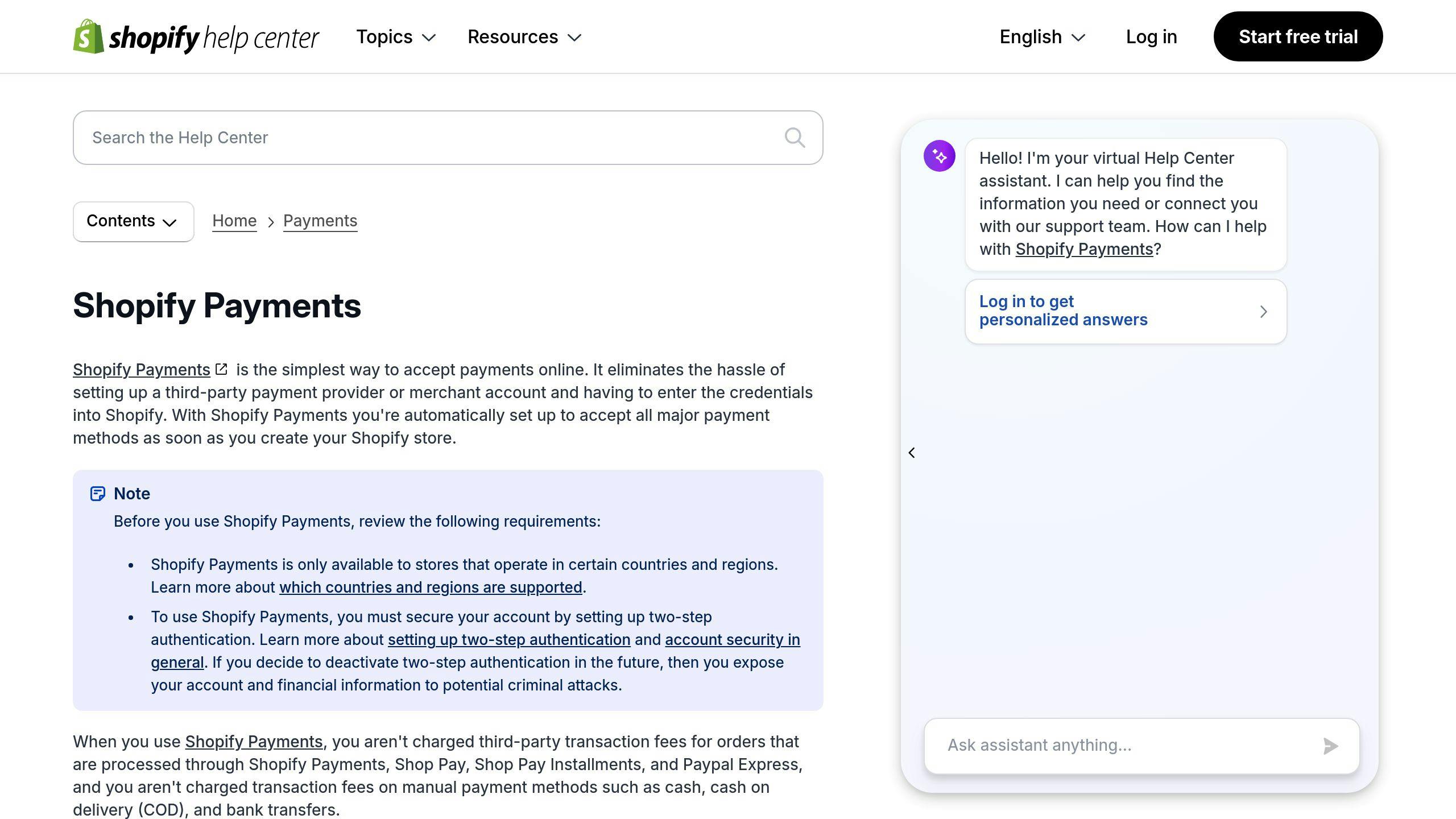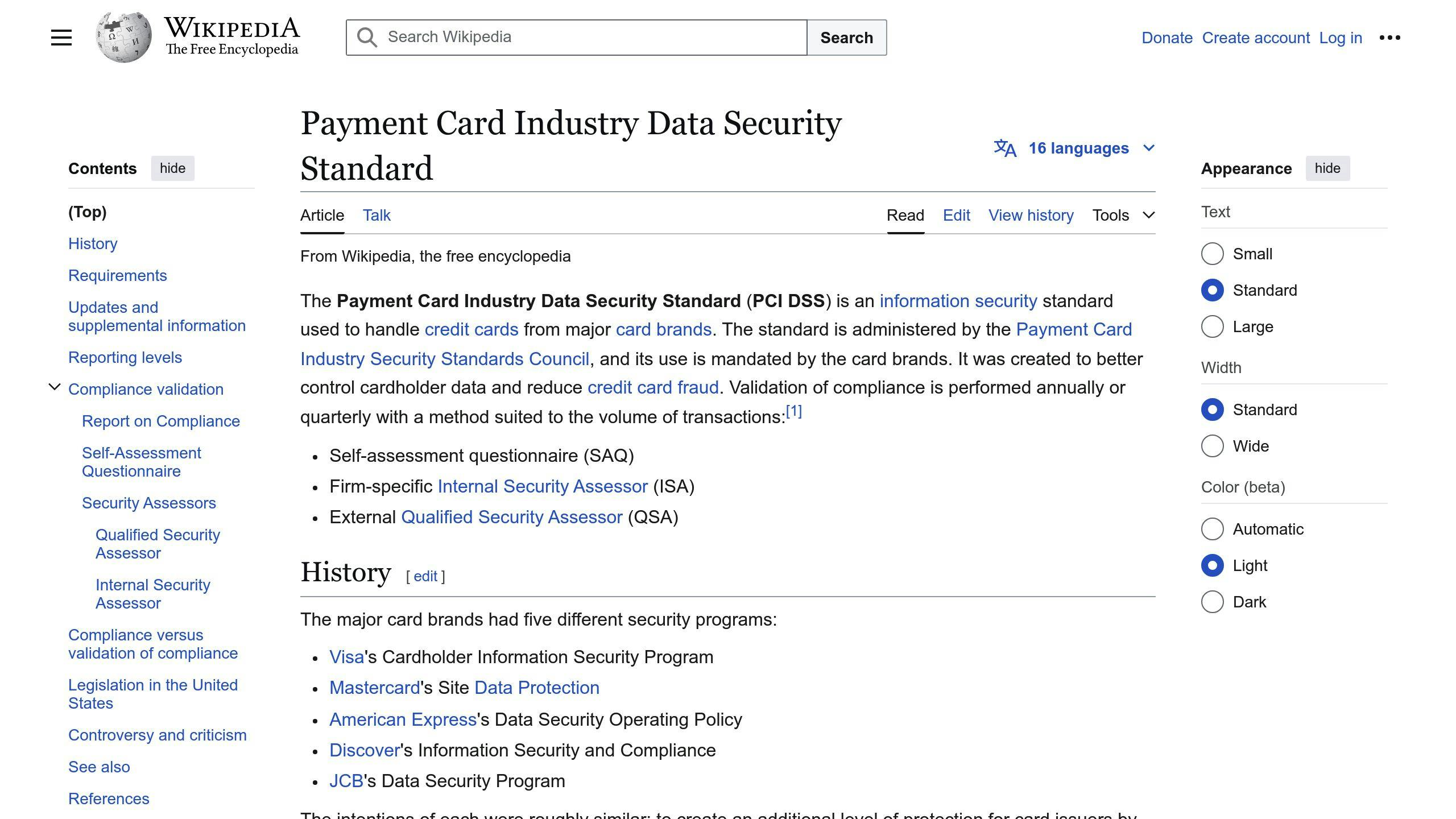Shopify Payment Security: Best Practices Guide 2024
October 6, 2024

Here’s what you need to know about keeping your Shopify store’s payments safe:
- Shopify provides robust built-in security features like SSL encryption and PCI DSS compliance
- Focus on encryption, fraud detection, and secure customer data handling
- Use strong passwords, enable two-factor authentication, and limit admin access
- Keep Shopify, themes, and apps updated to patch vulnerabilities
- Have an incident response plan ready in case of a security breach
Key security measures:
- Enable SSL encryption
- Use PCI-compliant payment gateways
- Set up fraud detection and prevention
- Implement strong authentication
- Regularly audit access and permissions
- Securely handle customer data
- Stay vigilant with security updates
Quick Comparison: Shopify Payments vs Other Gateways
| Feature | Shopify Payments | Other Gateways |
|---|---|---|
| Integration | Native | May require setup |
| Security | Built-in | Varies by provider |
| Fraud protection | Included | Often an add-on |
| Checkout experience | On-site | May redirect |
| Additional fees | None | Possible |
Remember: Good security builds customer trust and protects your business. Stay proactive and make security a priority for your Shopify store.
Related video from YouTube
Shopify‘s payment security features

Shopify takes security seriously. Here’s what you need to know about their built-in protections and payment options:
Built-in security tools
Shopify doesn’t skimp on keeping your store safe:
- SSL encryption: Free 256-bit SSL for all stores. It’s like a force field for your data.
- PCI DSS compliance: They meet the toughest standards for handling credit cards.
- Fraud analysis: Every order gets a once-over for sketchy behavior.
- Two-factor authentication (2FA): An extra wall between hackers and your account.
- Passkeys: New tech that lets users ditch passwords for things like fingerprints.
Shopify Payments vs. other gateways

Shopify Payments is their in-house system. Here’s how it stacks up:
| Feature | Shopify Payments | Other Gateways |
|---|---|---|
| Integration | Plug-and-play | Might need setup |
| Security | Top-notch | Usually solid, but varies |
| Fraud protection | Built-in | Often costs extra |
| Checkout | Stays on your site | Might send customers elsewhere |
| Fees | None with Shopify Payments | Watch out for extra charges |
Shopify Payments fits like a glove with your store. But other big names can work well too if they suit your needs better.
Bottom line: Shopify gives you a fortress of security tools. Their payment system adds extra armor, but don’t rule out other trusted options.
Key parts of payment security
Shopify stores need to focus on four main areas to keep payments safe:
Encryption and tokenization
These methods protect customer data during transactions:
- Encryption scrambles card details into unreadable code
- Tokenization replaces sensitive info with unique tokens
Shopify uses 256-bit SSL encryption for all stores. This makes it tough for hackers to steal data.
PCI DSS rules

The Payment Card Industry Data Security Standard (PCI DSS) sets the bar for handling card data. Shopify handles most PCI requirements, but store owners still need to:
- Use strong passwords
- Keep software up-to-date
- Limit access to customer data
| PCI Level | Annual Transactions | Key Requirements |
|---|---|---|
| 1 | 6+ million | On-site audit, quarterly scans |
| 2 | 1-6 million | Self-assessment, quarterly scans |
| 3 | 20k-1 million | Self-assessment, quarterly scans |
| 4 | <20k | Self-assessment, quarterly scans |
Spotting and stopping fraud
Fraud can hit your bottom line hard. Shopify’s built-in tools help flag risky orders:
- Green: Order looks good
- Red: Possible fraud
- Grey: Needs a closer look
For high-risk orders, check details, contact the customer, ask for more info if needed, put the order on hold if unsure, and cancel if it’s fraud.
"Almost half (43%) of businesses experienced phishing scams, making it the most common type of fraud."
Verifying user identity
Make sure customers are who they say they are:
- Use Shopify Payments for 3D Secure Checkout
- Add two-factor authentication (2FA) for account logins
- Consider IP fraud scoring to spot risky locations
Tips for Shopify store owners
Secure account management
Keep your Shopify store safe with strong account security:
- Use a password manager like 1Password
- Create individual accounts for team members
- Turn on Two-Factor Authentication (2FA) for all accounts
To set up 2FA:
- Log into Shopify admin
- Click your profile
- Go to "Manage Account" under "Security"
- Follow the prompts
Regular security checks
Stay on top of your store’s security:
- Update apps and themes ASAP
- Check account activity logs weekly
- Use security apps like Trustwave or Sucuri
IBM found that retail data breaches cost about $3.27 million on average in 2023.
That’s why regular checks matter.
Staff training and access limits
Educate your team and control access:
| Action | Purpose |
|---|---|
| Train staff | Spot phishing attempts |
| Limit permissions | Based on job roles |
| Use individual accounts | No shared logins |
| Review permissions | Check quarterly |
Customer identity checks
Protect customers and your business:
- Use Shopify Payments for 3D Secure Checkout
- Add address verification for credit cards
- Consider fraud analysis tools for risky orders
Advanced security steps
Want to beef up your Shopify store’s security? Here are some advanced steps:
Multi-factor authentication (MFA)
MFA is like adding a deadbolt to your store’s front door. Here’s how to set it up:
- Log into your Shopify admin panel
- Go to "Settings" > "Account"
- Under "Security", click "Enable two-step authentication"
- Pick your method: authenticator app, SMS code, security key, or Shopify Mobile prompt
Shopify’s security team says: "Enabling 2FA can prevent up to 99.9% of automated attacks."
IP address limits
Lock down access to your store:
- In Shopify admin, go to "Settings" > "Account"
- Under "Login security", add allowed IP addresses
- Save changes
This keeps out unwanted visitors from sketchy locations.
Safe API connections
Protect your store’s data with these API best practices:
| Do This | How |
|---|---|
| Use HTTPS | Always use https:// in API requests |
| Rotate API keys | Make new keys quarterly in Shopify admin |
| Limit permissions | Only give apps the access they need |
| Watch usage | Check API logs often for weird stuff |
Tracking system activity
Keep an eye on your store’s security:
- In Shopify admin, go to "Settings" > "Account"
- Click "View store activity"
- Check logs weekly for failed logins, product changes, and new apps
These steps will help keep your Shopify store locked down tight.
Managing customer data safely
Keeping customer data safe is crucial for Shopify store owners. Here’s how to handle sensitive info securely:
Collect less data
Only gather what you need:
- Essential checkout info (name, email, shipping address)
- Skip optional fields unless necessary
- Use Shopify’s built-in forms
Store data securely
Shopify’s security is solid, but take these extra steps:
- Enable Shopify’s 256-bit SSL certificate
- Use Shopify Payments (no card data on your servers)
- Keep apps and themes updated
"Shopify fully complies with PCI-DSS Level 1, meeting all six categories to ensure secure credit card data storage."
Delete payment info safely
Ditch unnecessary payment data:
| When | How |
|---|---|
| After refund period | Shopify’s bulk delete tool |
| Inactive customers | Automatic deletion rules |
| Customer request | GDPR guidelines |
Don’t ever store full card numbers or CVV codes. It’s against PCI standards and risky.
For EU customers, set up a GDPR-compliant system:
1. Create a form for data-related inquiries
2. Respond within 30 days
3. Document your data handling processes
sbb-itb-4bd9e2f
Third-party app security
Adding apps to your Shopify store can be great, but it’s not without risks. Here’s how to keep your payment data safe:
Checking payment apps
Before you add an app:
- Read reviews and ratings
- Check the developer’s reputation
- Look for security certifications
- Verify the app’s website and support
Take ReCharge, for example. This subscription payment processor is upfront about its security measures and PCI compliance. That’s the kind of transparency you want.
Setting app permissions
To limit app access:
- Review permissions during installation
- Only grant necessary access
- Be cautious of broad permissions like
read_all_orders - Regularly audit app permissions
| Permission | What it means | Use it for |
|---|---|---|
| Read-only | View data | Analytics apps |
| Write | Change specific data | Inventory management |
| Full access | Complete control | Essential, trusted apps only |
Keeping apps up-to-date
Old apps can be risky. To stay safe:
- Turn on automatic updates if you can
- Check for manual updates often
- Get rid of unused or old apps
- Pay attention to Shopify’s app safety alerts
Shopify’s team uses tech to spot bad behavior, but YOU’RE in charge of your store’s security.
Making checkout more secure
A secure checkout is crucial for your Shopify store. Here’s how to boost security without killing sales:
Safe checkout page design
Build a checkout page customers trust:
- HTTPS encryption (Shopify’s got you covered)
- Security badges and payment logos
- Clean, simple design
Allbirds nails this. Their checkout is clean with "Secure Checkout" text and payment logos.
Extra security features
Fight fraud with these tools:
- 3D Secure: Extra card ownership check
- AVS: Matches billing address to card records
- Captcha: Stops bot orders
Plus, Shopify’s fraud analysis flags sketchy orders.
Security vs. ease of use
It’s a balancing act. Too much security? Customers bail.
| Measure | Good | Bad |
|---|---|---|
| Guest checkout | 26% more likely to buy | Less customer data |
| One-click payment | Can boost sales 50% | Slightly higher fraud risk |
| Required accounts | More secure, repeat business | 22% might abandon cart |
Pro tip: Offer both guest checkout and accounts. Let customers pick.
Peepers crushed it by tweaking their Shopify checkout:
- Added cross-sells
- Showed customer reviews
- Easy live chat access
John Hart from Peepers said: "Customizing with Shopify lets us create a checkout customers trust with their info."
One last thing: Keep Shopify and apps updated. Old software = security risks.
Handling security problems
Security issues with Shopify payments? You need to be ready. Here’s how to tackle them head-on.
Creating a response plan
A solid plan is your best friend when things go south. Include these:
- Steps for different breach types
- Who does what during an incident
- Contact info for your team and outside help
- Guidelines for customer and public communication
"A data breach response checklist helps you act fast and smart, cutting down the damage." – IBM Cost of a Data Breach Report 2023
What to do during a breach
Spot a breach? Don’t panic. Do this:
1. Stop the bleeding
Take affected systems offline ASAP.
2. Rally the troops
Get your response team together.
3. Size up the damage
Figure out what happened and how bad it is.
4. Spread the word
Tell customers, law enforcement, and whoever else needs to know.
5. Patch it up
Fix the security hole that let the bad guys in.
| Step | Action | Why it’s crucial |
|---|---|---|
| 1 | Go offline | Stops data leak |
| 2 | Gather team | Coordinates response |
| 3 | Assess damage | Guides next moves |
| 4 | Notify others | Meets legal rules |
| 5 | Patch weakness | Stops repeat attacks |
Learning from incidents
Once the crisis is over, it’s school time:
- Review the incident and your response
- Beef up your security where it’s weak
- Train your team on new procedures
- Test your updated plan to make sure it works
Future of Shopify payment security
New security tech for online stores
Shopify’s gearing up for a security overhaul:
- AI fraud detection: By 2026, 80% of businesses will use AI APIs. Shopify’s jumping on this train, potentially slashing fraud costs by 90%.
- Biometric checkout: With biometrics booming ($42.9 billion in 2022), expect more fingerprint or face ID options when you pay.
- Blockchain payments: As blockchain security spending nears $19 billion by 2024, Shopify might tap into this for rock-solid transactions.
Shopify’s security plans
Shopify’s not resting on its laurels. Here’s what’s in the works:
1. Tougher dispute handling
Disputes are set to skyrocket to 337 million transactions by 2026. Shopify’s tackling this head-on:
- Quicker dispute resolution
- Smarter fraud screening
- Crystal-clear transaction data
2. Beefed-up authentication
Shopify’s doubling down on Multi-Factor Authentication (MFA):
| Now | Soon |
|---|---|
| MFA optional | MFA required for all |
| Basic 2FA | Advanced biometrics |
| Limited IP rules | Precise IP and location controls |
3. Always-on monitoring
Shopify’s security team is on constant alert:
- 24/7 system watch
- Regular security fixes
- Auto-backups to keep data safe
"We needed something that could be portable, extensible, and work anywhere if we wanted to make inroads off-platform." – Brian Donohue, senior product manager at Shopify, on developing Shop Pay
This focus on flexibility and security shows Shopify’s not messing around.
4. Tokenization push
Shopify’s betting big on tokenization:
- Safer payment info storage
- Smoother multi-channel buying
- Less PCI hassle for merchants
Wrap-up
Keeping your Shopify store secure is an ongoing process. Here’s what you need to focus on:
Lock it down
- Use strong, unique passwords (12+ characters)
- Enable 2FA for all accounts
- Limit admin access
Stay current
- Update Shopify, themes, and apps
- Remove unused apps
Protect customer info
- Use SSL encryption
- Choose PCI DSS-compliant payment gateways
- Don’t store payment data yourself
Stay vigilant
- Check logs regularly
- Set up login alerts
Keep improving
1. Learn constantly
Security threats evolve. Keep yourself and your team informed about new risks.
2. Be prepared
Have a clear action plan ready for security incidents. Know who to contact and what steps to take.
3. Test your security
Regularly check your store’s defenses. Use tools or hire experts to find vulnerabilities.
4. Follow the experts
Stay updated on Shopify and security professionals’ advice about emerging threats and solutions.
Remember: Cyber threats don’t take breaks, so neither can your security efforts.
Checklist: Shopify store security
Here’s how to boost your Shopify store’s security:
1. Enable SSL encryption
Make sure your store URL starts with HTTPS. Turn on SSL in Shopify admin settings.
2. Use strong authentication
Create complex passwords (12+ characters, mix it up). Turn on two-factor authentication (2FA) for all accounts.
3. Manage access carefully
Give team members their own accounts. Only grant necessary permissions. Review access rights often.
4. Secure payments
Use PCI DSS compliant gateways like Shopify Payments. Don’t store customer payment data yourself.
5. Keep everything updated
Turn on auto-updates for Shopify, themes, and apps. Check for manual updates regularly.
6. Watch store activity
Check logins and transactions often. Set alerts for big changes or weird activity.
7. Fight bots and fraud
Use Google reCAPTCHA for forms. Try Shopify’s built-in fraud tools.
8. Back up your data
Use apps like Rewind for auto-backups. Manually export important stuff sometimes.
9. Protect customer info
Use GDPR-compliant cookie consent. Encrypt sensitive data.
10. Train your team
Give regular security lessons. Teach them to spot phishing.
11. Do security checks
Use scanning tools or hire pros. Fix problems fast.
12. Guard against regional threats
Block countries or IPs if needed. Try apps like Blocky.
 Checkout Links
Checkout Links



